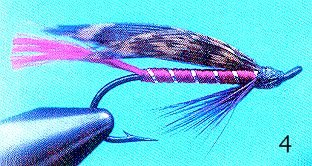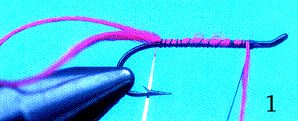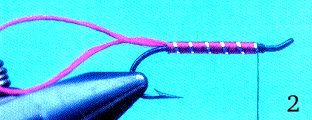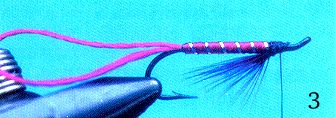
Great Canadian Flies - The Dark Montreal
Text by Sheldon Seale
Photos by Glen Hales
Nearly every list of fly patterns for the last century includes at least
one pattern named the Dark Montreal (or simply the Montreal). Like
so many other popular patterns, it comes in a number of variations.
Credit for the Montreal is usually given to Peter Cowan, a Scot who
emigrated to Canada as a young man in the 1830s and settled in Quebec's
Eastern Townships sometime before 1836, where he built a home on the
banks of the Yamaska River. The town of Cowansville, where he was
sheriff between 1866 and 1880, was named in his honour. He chose the
area partly because there was good trout fishing to be had in the local
streams. We are reasonably certain he was fishing the pattern that would
become the Montreal by the 1840s and was having very good success
with it. He seems to have given the pattern to a number of other fly fishers,
who also found it very effective. Eventually, the popularity of the pattern
grew so much that Cowan showed the pattern to a professional fly-maker
in Montreal around 1850, who started to supply the demand.
That fly-maker could have been William Forster, an American who began
tying flies professionally in Montreal in about 1849. Forster claimed to have
originated the pattern himself and named the mainly claret coloured wet fly
the Montreal in honour of the city in which he lived at the time. There is
no conclusive evidence for either Cowan's or Forster's claim, but there is
no doubt whatsover that it was originated and developed in Quebec.
The popularity of the Montreal (today generally referred to as the Dark
Montreal) grew as Cowan invited the English army officers stationed in
Montreal to fish with him. The officers sent the pattern back to England
where the local fly-makers were soon making and selling the Montreal
wherever trout fishing thrived (which, thanks largely to the British, was
practically everywhere). After 150 years, the Montreal is still a widely
recognized pattern and a favourite among wet fly anglers worldwide.
That it has stood the test of time is indicative of its success.
MODERN RECIPE
- Hook: Any wet fly hook, sizes 2-14. I like a longer hook with
a turned up eye. The photos show a Mustad 36890 salmon wet fly hook,
size 6.
- Thread: Black, 6/0.
- Wing: 2 natural dun CDC plumes.
- Rib: Oval or flat gold or silver tinsel, narrow in small sizes.
- Tail: Claret floss.
- Body: Claret floss.
- Hackle: Claret dyed cock (Chinese necks are good for this).
- Wing: Mottled, brown turkey.
TYING INSTRUCTIONS

Step 1
Start black thread near the eye (leave only enough room for
a throat hackle, the base of the wings, and a small, neat head). Tie
in a length of small, oval tinsel and wrap the thread back to the bend,
securing the tinsel along the far side of the hook, almost underneath.
Form a loop of claret floss out past the hook bend and wrap the thread
forward to the tie-in point. Trim one end of the floss leaving one long
end out over the eye of the hook. The long end will be used to form
the body.

Step 2
Wrap the floss back to the bend and forward to the tie-in point to form
the body. By twisting the floss, you can control the thickness of the layers
to form a slightly cigar shaped body (i.e. tapered somewhat at both ends).
Secure the floss at the tie-in point with 3 tight wraps of thread and trim the
excess floss. Counter-wind the tinsel, using 5-6 wraps, to form the rib.
Secure the tinsel as with the floss and trim the excess.

Step 3
Tie in the throat hackle (see Throat Hackle below) and prepare a neat
base of thread wraps as the tie-in point for the wings. This step is crucial
to the overall look of the fly. It adds the throat hackle and forms the base
for the wings. Great care should be taken in this step to build a smooth
tie-in point for the wings, or they will not lay back over the body correctly.

Step 4
To prepare the wing, cut slips from a pair of matched brown mottled
turkey quills (a left and a right). Mount the 2 slips, concave sides
together and tips even, and tie them in, with a full, soft loop (see Soft
Loops below), to form the wings. They should be flat on the bottom
with the curve of the wings pointing down to the tail. They should lay
down close to the body at an angle of no more than 15 to 20 degrees
from the hook shank. Trim the excess material and form a small, neat
head of thread. Whip finish, trim, and apply head cement or lacquer.
Trim the loop of floss to make a tail about as long as the body of the fly,
and your Dark Montreal is complete.
Throat Hackles
Some tyers have trouble with throat hackles. There are a number of
approaches to tying in a throat hackle. Stripping some hackle fibers
from a feather and tying them in underneath the hook near the eye is
one approach. This is usually termed a "false beard." Trim the excess
material leaving a throat hackle that reaches down and back at a 45 degree
angle to the hook point. Another approach is to prepare a hackle with
fibers of the desired length and tie it in by the butt. Wrap 3-4 turns of
hackle, with each wrap touching the previous. Secure the tip with 2-3
tight wraps of thread then, waggling the thread back and forth as you go,
take 2 tight wraps back through the hackle to immediately in front of the
body. Trim the hackle tip, stroke the fibers down below the hook to form
the beard and take 2-3 tight wraps of thread to secure the beard. This is
a more traditional way of forming a throat hackle.
Soft Loops
The best approach for tying in quill slip wings for wet or dry flies is the
soft loop. The idea is to form a loop all the way around the wing material
and the hook, so that when the thread is tightened, it closes evenly without
twisting the material. Hold the matched slips between your thumb and index
finger of the left hand (for right handed tyers) and hold them on top of the
hook at the tie in point (tips forward for dry flies, rearward for wet, parallel
to the hook shank). To form a soft loop, trap the thread between your thumb
and the near side of the hook. Form a loose half loop over the hook and trap
the thread between your index finger and the far side of the hook. Form a
second loose half loop under the hook, trapping the thread from below
between your thumb and the near side of the hook shank again. A full, soft
loop has been formed. Drawing the thread upward, slowly tighten the thread.
The tension between the index finger and your thumb is used to guide the
quill slip fibers, stacking them evenly. Too much tension and you'll cut
through the fibers with the thread, so go easy. The tightness of this first
wrap will determine the angle at which the wing will lie over the hook on
wet flies. The tighter, the more acute the angle. For dry flies, make the
first loop fairly tight. Finally, secure the wing with 3 progressively tighter
wraps of thread, remove your hand while maintaining thread tension, and
have a look. If everything looks OK, add 3 more temporary wraps in place,
trim the excess material and remove the last 3 wraps.

Fishing the Montreal
Fish the Montreal as a standard wet fly, down and across, controlling the
swing with line mends. The pattern, in appropriate sizes, may imitate an
Isonychia nymph or a small, colourful baitfish, such as the Rainbow
Darter. It's simply an attractor pattern that could represent a wide range
of possible food items which many species of fish find interesting. It's
important to note that the Montreal started life as a brook trout pattern.
However, it will take many other species of trout including browns,
rainbows and cutthroats. When tied in larger sizes, it's also effective
for steelhead, Atlantic salmon and smallmouth bass, and there's no reason
why it couldn't take many other species as well.
VARIATIONS
|
| Name |
Wing |
Hackle |
Body |
Rib |
Tail |
Tag |
| Blue Montreal |
blue |
claret |
claret floss |
gold |
blue |
(none) |
| Western Claret Montreal |
brown turkey |
dyed claret |
claret |
claret floss |
gold |
claret |
| Original Dark Montreal |
brown turkey |
claret |
claret floss |
gold |
scarlet |
(none) |
| Light Montreal #1 |
gray turkey |
claret |
scarlet floss |
gold |
gray turkey |
gold |
| Light Montreal #2 |
mallard |
scarlet |
scarlet floss |
gold |
mallard |
(none) |
| Original Montreal |
mallard |
ginger |
scarlet mohair |
gold |
(none) |
(none) |
| Silver Montreal |
brown turkey |
claret |
silver |
(none) |
scarlet |
(none) |
| White-tip Montreal |
black turkey |
white tipped |
claret |
claret floss |
gold |
scarlet |
| Yellow Montreal |
brown turkey |
claret |
yellow floss |
gold |
scarlet |
gold |
| Steelhead Montreal |
gray squirrel |
claret |
claret wool |
gold |
scarlet |
(none) |
| Claret Montreal |
brown turkey |
dyed claret |
claret |
claret floss |
gold |
scarlet goose |
|













